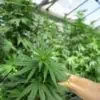TABLE OF CONTENTS
You might be asking yourself the question “what is bhang?” Is it the same thing as grass, hashish, reefer, tea, hemp, or pot?
Bhang has been around for thousands of years and traces its roots back to the Asian continent. It is a paste that is made from the leaves and flowers of the female marijuana plant. The parts are soaked in water and crushed to a fine paste and can be used to create different products when added to foods and drinks.
In India the paste is usually rolled into balls which are greenish brown and shiny in color and are known as bhang goli. Bhang thandai which is also popular is made by mixing the marijuana paste with milk, groundnuts and choice spices. Bhang lassi is made by mixing the paste with curd from milk.
The bhang paste is used for religious, therapeutic, and recreational purposes. In India, it is associated with religious festivals. When mixed with sugar and ghee, it is eaten recreationally as candy.
How Does Bhang Work?
Bhang is made from the bioactive components of the marijuana plant. This includes cannabinoids, terpenes, and flavonoids. These compounds are responsible for the effects that are produced when bhang is consumed.
The major cannabinoids in bhang are tetrahydrocannabinol (THC) and cannabidiol (CBD). These compounds are similar to endocannabinoids which occur naturally in the human (mammalian) body. They interact with the endocannabinoid system (ECS) which is responsible for maintaining homeostasis in the body.
This system regulates vital functions such as pain regulation, temperature control, metabolism, hunger, memory, moods, reproduction, and immunity among others. The ECS has receptors which the endocannabinoids interact with.
THC and CBD interact with this receptors through different mechanisms. By doing this, they are able to influence the functions that are controlled by the ECS.
THC causes psychoactive effects by interacting with the endocannabinoids receptors that are present in the central nervous system (CNS). CBD does not have similar effects in the CNS. However, both compounds have similar therapeutic effects.
When you consume bhang in whatever form you are likely to experience similar effects as a result of the cannabinoids interacting with the endocannabinoid system. If you smoke it you should expect to start feeling the effects within 15-30 minutes. When you ingest it the effects should peak in 2-3 hours.
Does Bhang Have Any Therapeutic Benefits?
Some of the therapeutic benefits include:
- Preventing nausea and vomiting especially in patients with chronic conditions
- Reducing pain and inflammation
- Treating seizures
- Treating insomnia and irregular sleep
- Offer anticancer benefits
- Improving appetite
- Treating mood disorders
- Relieving anxiety
Each individual has a unique endocannabinoid system and will have a different experience with bhang. Bhang that has a high amount of THC can cause paranoia and should be consumed in moderation.
Are There Risks Associated With Bhang Consumption?
Consuming high amounts of bhang may cause some negative effects, especially when high amounts of THC are consumed. As much as THC causes desirable stimulation it may cause excessive paranoia or psychosis. It may also impair short term memory when used for prolonged durations of time. However, there is conflicting evidence on the link between marijuana and memory.
Marijuana has also been associated with mental disorders such as schizophrenia. However, there is no sufficient evidence to support this claim.
Consuming bhang during pregnancy may also affect the developing child. While some sources claim that marijuana will affect the developing child negatively, some Jamaican research has shown a positive link. Some sources claim that marijuana for pain control is a safer alternative as compared to conventional pain killers.
How To Make Bhang Thandai
Bhang thandai is a popular form of bhang especially in India. Here is a simple recipe for making thandai.
Prep Time: 2 Hours
Ingredients
- 1 1/2 cups Sugar
- 3 Cups water
- 1 cup – Milk
- 1 Teaspoon cardamom powder
- Chopped almonds for garnishing
- 15 grams of dried flower from your favorite cannabis strain
Method
“
There are over 300,000 jobs in the cannabis industry. CTU trained me for one of them!

Makes $24.50 @ THC +
- Take half a cup of water and add the sugar and let it soak for half an hour to create a sugar syrup
- Take the chopped marijuana leaves and flowers and add two cups of water and let it soak for two hours. After this grind the mixture to a fine paste
- Add the remaining water to the paste and strain using a muslin bag
- Now add the sugar syrup to the strained paste
- Add the milk and spices gradually as you stir
- Chill in the refrigerator until it is cold
- Serve chilled with a garnishing of chopped almonds
Bhang which was once popular in India is also catching up in other parts of the world. Due to its myriad of benefits, it is now consumed widely across different age groups.
It remains illegal in different parts of the world because of the psychoactive properties of THC.

Gavin Kushman
Gavin is a worldly adventurer and cannabis connoisseur, embarking on journeys that take him to the far corners of the globe to explore and document the varied effects, flavors, and histories of both renowned and lesser-known strains. From the misty high-altitude farms of the Hindu Kush highlands to the vibrant cannabis cafes of Amsterdam, Gavin's quest for knowledge spans continents. A recognized authority in the cannabis industry, he frequently lends his expertise to leading publications such as Cannabis Training University, where his captivating blog articles chronicle his unique experiences with different cannabis strains.












 Jeff was involved in an accident where he endured a traumatic brain injury. He had a week-long stay in ICU where brain surgeons
Jeff was involved in an accident where he endured a traumatic brain injury. He had a week-long stay in ICU where brain surgeons  100% risk free money back guarantee within 48 hours after purchase if student has not completed any of the courses or exams.
100% risk free money back guarantee within 48 hours after purchase if student has not completed any of the courses or exams.